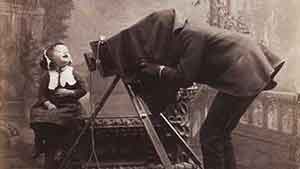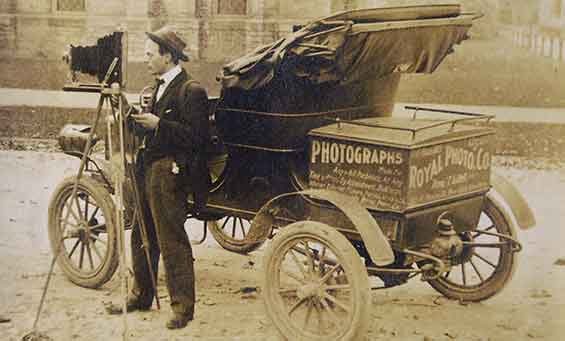Take a picture … it lasts longer

Broom brigades were a popular form of recreational exercise for young women in the 19th century. This group is likely from Ann Arbor. (Albumen print, circa 1880s.) View gallery.
Thirty years ago, the quantity of historical photography at the William L. Clements Library barely merited the term “collection.” Born of small groups of portraits and albums acquired with manuscript collections, today’s holdings amount to more than 60,000 photographic images. This number is expected to double in the coming few years.
The Clements Library has been very successful in acquiring important photographic materials individually and in large groups, such as the James S. Schoff Civil War Collection, the highly diverse Frederick P. Currier Collection, and the Mark A. Anderson Collection of Post-Mortem Photography. But it is largely the addition of the remarkable David V. Tinder Collection of Michigan Photography that has caused the huge expansion of photographic holdings at the Clements.
The Tinder collection contains examples of virtually every photographic format in use in the Great Lakes State during the 19th and early 20th centuries, including daguerreotypes, ambrotypes, cartes de visites, cabinet photographs, tintypes, stereographs, real-photo postcards, and mounted and un-mounted paper prints. These materials are primarily vernacular photographs of life in Michigan, taken by both professionals and amateurs from the 1840s into the mid-20th century. When fully available, the David V. Tinder Collection of Michigan Photography at the Clements Library will contain approximately 100,000 vintage images.
100,000 images, countless subjects

This charming “cabinet photograph” may be of Allegan County photographer Wilson H. Blair and his daughter, Vera, circa 1889. View gallery.
This vast pool of visual information will provide exceptional resources for the study of agriculture, mining, lumbering, industry, urban and suburban culture, portraiture, domestic life, leisure, travel, transportation, and many other subjects. In addition to supporting local history research, the collection offers evidence for the study of wider topics, such as the transformations caused by the exploitation of natural resources, the industrialization of American cities and occupations, changes in fashion and dress, racial and cultural identity, the role of fraternal organizations in society, and the uses of photography in business, domestic, and social life.
The landmark acquisition of the Tinder collection was made possible by David B. Walters, who wished to honor Harold L. Walters, BSEng ’47, and Marilyn S. Walters, LSA ’50. Substantial donations to the collection also have been made by Tinder, his friends, and family members.
Special collections
Tinder’s collecting career has had many incarnations. Tiffany glass, Japanese metalwork, and antique ceramics all have had a place in his home. Inspired by William C. Darrah’s 1964 book, A History of Stereographs in America and Their Collection, Tinder amassed a large number of international photographic stereo views. By the early 1970s he began trading his international collection for Michigan stereo views and commenced seriously collecting other early photographic formats related to Michigan subjects and photographers.
As he collected, Tinder became increasingly interested in the lives and careers of the early photographers and began compiling The Directory of Early Michigan Photographers. This led to the recognition of Tinder as the authority on the subject. Over time, he expanded the scope of his collection to include real-photo postcards and other formats from the 20th century, and the research period for the directory was extended to include photographers who were active before 1920.
Setting a new standard
Many regional directories of historical photography have been published, but Tinder’s work sets a new standard for inclusiveness, scope, and detail. While a dearth of information has kept some entries brief, the lives of many Michigan photographers have been traced “from the cradle to the grave,” as Tinder likes to say. With more than 8,000 records, the directory stands as an unsurpassed resource for historians, collectors, curators, archivists, genealogists, and anyone interested in the early history of photography in the United States.
The significance of Tinder’s achievements as a collector and scholar came to the attention of the Clements Library staff in 2002; the staff has since developed a close relationship with him. Tinder is enthusiastic about his collection and work becoming a resource for others to use, and he has agreed to make the text of his directory available online through the Clements Library’s website.
The Clements is grateful for the support of the Michigan Photographic Historical Society, which provided three paid summer internships to assist with the processing and cataloging of the Tinder collection. The library also has benefited from the substantial contributions of many excellent volunteers, student workers, and temporary employees, including Joel Hickey, Les High, William Lewis, Jorge Lopez-McKnight, Megan Marion, Lori Mott, Eve Neiger, Marjorie O’Brien, May Oyler, Diana Sykes, James Thiry, Jayne Ptolemy, and Michael Wesenberg.
Tinder continues to actively collect Michigan images and is enthusiastically revising and expanding the Directory of Early Michigan Photographers for the next iteration.
Top Image: Royal T. Gillette with his camera and car. (Gelatin silver print by the Royal Photo Company, circa 1907.) Gillette was an entrepreneurial photographer in the Grand Rapids area who used several automobiles for both expanding his territory and promoting his business.



David Giltrow - 1961
I look forward to additional news of the Clements Library’s expanding collection of Michigan photography. Could I suggest that the curator approach Ann Arbor’s own Dale Fisher about housing his archives at the Clements? His distinctive aerial color photography of many areas in Michigan (including Detroit of about 15-20 years ago) are unique.
During my time at the U-M as an undergrad, I came to know the Clements and especially recall the political illustrations from the 19th century, expanding my view of what a library can be. –David Giltrow, Ph.D., Santa Fe, New Mexico.
Reply
shirley herrud
I would like to know about the David Tinder collection. It is a marvelous history but I am very confused because I have two original pictures which I believe are my 5th great grandparents taken at the J M Brigham Studio in Plainwell Michigan around 1850 but the studio supposedly didn’t exist then. Can you help me find someone who can help me with this dilema? Thank you so very much!
Reply
Deborah Holdship
I forwarded your email to the Clements Library, whose staff may be able to help you. Meanwhile, see the comment here by Randy Gladstone. He also may have some information that could help you. Best of luck! Ed.
Reply
Randy Gladstone
To whom it may concern, we lost Mr. Tinder on July 19, 2016, age 90. I will be doing the additions to Mr. Tinder’s Early Michigan Photographer’s Directory. You may email me directly randygladstone@yahoo.com
Thank you, Randy S. Gladstone
517-676-9090
Reply